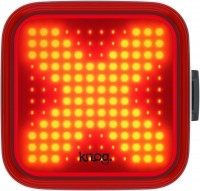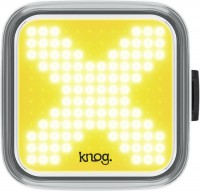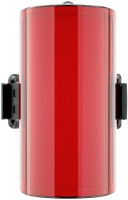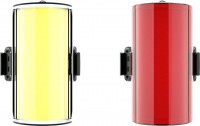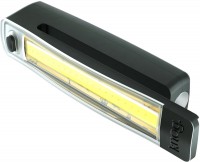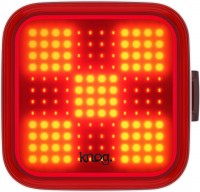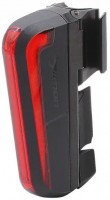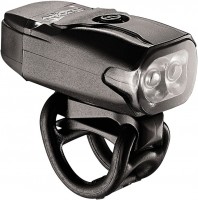Bike Lights Lezyne
All Bike Lights Advanced filters → |
You might be interested in
Bike Lights: specifications, types
Type
The type determines the purpose and configuration of the lantern.
— Velofara. A device similar to car headlights and designed to illuminate the road in front of the cyclist, as well as to increase its visibility. In many countries, the use of a bicycle headlight at night or in low visibility conditions is mandatory; and even if there is no such prescription in the law, driving without lights in poor visibility is simply unwise and unsafe. The headlight, usually, is mounted on the steering wheel and rotates with it; many of these devices have a strobe mode to further improve visibility.
— Flasher. Auxiliary lamp mounted at the rear of the bicycle. Usually, flashing lights are made red (although there are other colours) and are not intended for lighting, but solely to make the cyclist more visible to other road users. Unlike headlights, such equipment is rarely mandatory even at night, however, from the point of view of traffic safety, it is much more effective and preferable than simple reflectors (reflectors). Note that, despite the name, flashers do not necessarily work only in flashing mode — usually, the design also provides for a constant light mode.
— Velofara + flasher. A kit that includes both of the devices described above — a bicycle headlight and a flasher. The point of this option is that the cyclist can purchase both the front and rear lights at once, instead...of buying them one at a time. On the other hand, buying separately gives you the opportunity to choose the lights at your discretion, while in this case you have to rely on the decision of the manufacturer. Therefore, the “bicycle headlight + flasher” kits have not received much distribution.
— Velofara. A device similar to car headlights and designed to illuminate the road in front of the cyclist, as well as to increase its visibility. In many countries, the use of a bicycle headlight at night or in low visibility conditions is mandatory; and even if there is no such prescription in the law, driving without lights in poor visibility is simply unwise and unsafe. The headlight, usually, is mounted on the steering wheel and rotates with it; many of these devices have a strobe mode to further improve visibility.
— Flasher. Auxiliary lamp mounted at the rear of the bicycle. Usually, flashing lights are made red (although there are other colours) and are not intended for lighting, but solely to make the cyclist more visible to other road users. Unlike headlights, such equipment is rarely mandatory even at night, however, from the point of view of traffic safety, it is much more effective and preferable than simple reflectors (reflectors). Note that, despite the name, flashers do not necessarily work only in flashing mode — usually, the design also provides for a constant light mode.
— Velofara + flasher. A kit that includes both of the devices described above — a bicycle headlight and a flasher. The point of this option is that the cyclist can purchase both the front and rear lights at once, instead...of buying them one at a time. On the other hand, buying separately gives you the opportunity to choose the lights at your discretion, while in this case you have to rely on the decision of the manufacturer. Therefore, the “bicycle headlight + flasher” kits have not received much distribution.
Smart lighting
The presence in the headlight of "smart" control electronics, providing various advanced features. So, bike lights with smart lighting are usually able to adapt to the speed of movement: the faster the cyclist rides, the farther the headlight shines. Such a device receives speed data from a bike computer or other control gadget. The rear “flasher” with this feature can be synchronized with the brakes and, when braking, turn on at maximum brightness, playing the role of a brake light. Another possibility found in "smart" lamps is wireless remote control. Thanks to this, you can give commands to the headlight from the remote control on the handlebars, as well as turn the lights on and off at a certain distance from the bike. Other functions may be provided, depending on the model. Among the disadvantages of such devices, in addition to the high cost, one can name the fact that a compatible external gadget may be needed for operation.
LED
The number of individual light emitting diodes (LED) in the bike light (see "Type").
A larger number of LEDs, on the one hand, makes it possible to achieve greater brightness of the headlight and reduces the likelihood of its complete failure (the failure of one LED does not lead to a loss of lamp operation). On the other hand, the technical features of modern LEDs are such that manufacturers prefer to put one bright single-chip LED instead of several case ones into powerful “long-range” bicycle lights. On the third, there can also be several single-chip LEDs, to increase reliability and provide additional adjustments (for example, changing the brightness by turning on / off individual LEDs). Therefore, only lamps of the same price category should be compared by this parameter. At the same time, “multiple-charged” models, in addition to the described advantages, also have disadvantages — they are, usually, more complicated, more expensive and larger.
A larger number of LEDs, on the one hand, makes it possible to achieve greater brightness of the headlight and reduces the likelihood of its complete failure (the failure of one LED does not lead to a loss of lamp operation). On the other hand, the technical features of modern LEDs are such that manufacturers prefer to put one bright single-chip LED instead of several case ones into powerful “long-range” bicycle lights. On the third, there can also be several single-chip LEDs, to increase reliability and provide additional adjustments (for example, changing the brightness by turning on / off individual LEDs). Therefore, only lamps of the same price category should be compared by this parameter. At the same time, “multiple-charged” models, in addition to the described advantages, also have disadvantages — they are, usually, more complicated, more expensive and larger.
Output
Luminous flux given out by a bicycle headlight (see "Type"); in models with adjustable brightness, usually, the maximum value is indicated.
The higher the luminous flux, the brighter the headlight and the greater the illumination range (see below). On the other hand, this characteristic significantly affects the dimensions, weight and cost of the flashlight, despite the fact that high brightness is not always required — for example, for episodic trips along well-lit city streets, a powerful flashlight is not needed. Therefore, it is worth choosing a bicycle headlight according to the luminous flux, taking into account the features of the planned application; specific recommendations for different cases (city, highway, rough terrain, etc.) can be found in special sources. Also, do not forget that the actual lighting efficiency depends not only on the brightness, but also on the shape of the light spot.
The higher the luminous flux, the brighter the headlight and the greater the illumination range (see below). On the other hand, this characteristic significantly affects the dimensions, weight and cost of the flashlight, despite the fact that high brightness is not always required — for example, for episodic trips along well-lit city streets, a powerful flashlight is not needed. Therefore, it is worth choosing a bicycle headlight according to the luminous flux, taking into account the features of the planned application; specific recommendations for different cases (city, highway, rough terrain, etc.) can be found in special sources. Also, do not forget that the actual lighting efficiency depends not only on the brightness, but also on the shape of the light spot.
Illumination range
The greatest range at which a bicycle headlight (see "Type") provides effective illumination. The criteria for what is considered effective lighting are very arbitrary and may be different for different manufacturers; therefore this figure is approximate. Nevertheless, it allows you to fairly accurately assess the effectiveness of the flashlight and is more visual than the value of the luminous flux (see above). It is also worth choosing a bicycle headlight according to the range, taking into account the intended application; here note that in some (especially inexpensive) models, “range” can be achieved by narrowing the beam and, accordingly, reducing the light spot.
Operating modes
The number of individual operating modes provided in the bike headlight (see "Type"). Usually, this parameter takes into account all available adjustments: for example, for a model with 3 brightness adjustments and the ability to work in the stroboscope format, 6 modes will be indicated (3 brightness values \u200b\u200bfor constant light and the same for a stroboscope). A specific set of modes in each case should be clarified separately, but in general, the more there are, the more options for use the headlight suggests, the higher the likelihood that an unforeseen situation will not take the owner by surprise.
Brightness modes
The number of brightness modes makes it possible to adjust the intensity of the flashlight and adjust it to the necessary needs. Accordingly, the more modes, the more flexible options for using the model (even not only in cycling needs). So the most popular are models with brightness control in 3 or 4 positions.
Max. operating time
The longest time of continuous operation without replacing or recharging the power source, provided by a bicycle headlight (see "Type") in constant light mode (if there is a flashing mode, the operation time is usually longer, but it cannot be called the main one). This item indicates the value for the most economical format of operation, at minimum brightness; therefore, the actual headlight run time will generally be lower than advertised. It is also worth considering that many replaceable batteries (see "Power") are available in different capacities and have different durability — which means that battery life will also depend on the quality of the batteries. At the same time, this indicator is quite suitable for evaluating bicycle headlights and for comparing them with each other.
Max. brightness operation time
Bicycle headlight battery life at maximum brightness (see "Type"). This indicator is closer to reality than the maximum operating time (see above): in fact, it indicates the time that the flashlight is guaranteed to be able to work without replacing or recharging the battery. However note that some batteries (see "Power") can be produced in different capacities, and the manufacturer usually indicates the operating time for the most capacious (and expensive) batteries.
Power source
The type and number of batteries used by the bike light.
All elements, except for the proprietary batteries (see below), are removable and, usually, quickly replaced; many of them are available in two versions — disposable batteries and rechargeable batteries. The advantage of batteries is their low cost, but they need to be bought regularly; rechargeable batteries are noticeably more expensive, but once you buy a kit and a charger, you will no longer need to spend money on batteries.
— AA. One of the most popular modern standard sizes. However, in bicycle lights, such elements are used infrequently — in particular, because of the relatively large size. There are many brands of AA batteries on the market, differing in capacity and, accordingly, operating time.
— AAA. A smaller version of the AA batteries described above. Due to their compact size, they are well suited for bicycle lights; and the capacity of such batteries, although rather low, is quite sufficient, taking into account the specifics of use (flashing lights most often do not differ in significant power consumption).
— CR2032. One of the most popular and largest types of coin batteries, with a diameter of 20 mm and a thickness of 2.3 mm. At the same time, the dimensions of such batteries are very compact, which, combined with good capacity specs, makes them very...convenient for flashing lights. Typically, CR2032 cells are sold as disposable batteries.
— CR1025. Another type of coin battery is 10 mm in diameter and 2.5 mm thick. Due to their smaller size, they are noticeably inferior to RS2032 in terms of capacity, which is why they are used very rarely — mainly in flashing lights of low brightness, created with an emphasis primarily on compactness.
— LR44. Coin batteries (usually disposable) with a diameter of 11.6 mm and a thickness of 5.4 mm. The features are similar to those described above CR1025 but they are even rarer.
— LR01. Also known as LR1 or N. They are produced mainly in the form of disposable batteries, they are cylindrical, 30.2 mm long, and 12 mm in diameter (thus, LR01 is shorter than AAA battery, but noticeably thicker). Such batteries are considered optimal for devices with high current consumption. However, such devices are relatively rare among bicycle lights, and therefore LR01 has not received much distribution.
— 18650. Elements are usually made in the form of lithium-ion rechargeable batteries. Similar in shape to AA battery, but larger, with higher capacitance, and a higher voltage of 3.7V. 18650 cells are designed for high-power devices; therefore, in the case of bicycle lights, such power is a sign of a high-end model, with very high brightness levels and a long battery life. There are few such models on the market.
— Proprietary rechargeable batteries. This category includes all proprietary batteries that do not belong to any of the standard sizes, and often non-removable ones. In the case of bicycle lights, the convenience of the battery lies in the fact that it is immediately supplied in the kit. On the other hand, such a battery in the event of a discharge cannot be quickly replaced with a fresh one. However, the battery life is usually quite decent.
All elements, except for the proprietary batteries (see below), are removable and, usually, quickly replaced; many of them are available in two versions — disposable batteries and rechargeable batteries. The advantage of batteries is their low cost, but they need to be bought regularly; rechargeable batteries are noticeably more expensive, but once you buy a kit and a charger, you will no longer need to spend money on batteries.
— AA. One of the most popular modern standard sizes. However, in bicycle lights, such elements are used infrequently — in particular, because of the relatively large size. There are many brands of AA batteries on the market, differing in capacity and, accordingly, operating time.
— AAA. A smaller version of the AA batteries described above. Due to their compact size, they are well suited for bicycle lights; and the capacity of such batteries, although rather low, is quite sufficient, taking into account the specifics of use (flashing lights most often do not differ in significant power consumption).
— CR2032. One of the most popular and largest types of coin batteries, with a diameter of 20 mm and a thickness of 2.3 mm. At the same time, the dimensions of such batteries are very compact, which, combined with good capacity specs, makes them very...convenient for flashing lights. Typically, CR2032 cells are sold as disposable batteries.
— CR1025. Another type of coin battery is 10 mm in diameter and 2.5 mm thick. Due to their smaller size, they are noticeably inferior to RS2032 in terms of capacity, which is why they are used very rarely — mainly in flashing lights of low brightness, created with an emphasis primarily on compactness.
— LR44. Coin batteries (usually disposable) with a diameter of 11.6 mm and a thickness of 5.4 mm. The features are similar to those described above CR1025 but they are even rarer.
— LR01. Also known as LR1 or N. They are produced mainly in the form of disposable batteries, they are cylindrical, 30.2 mm long, and 12 mm in diameter (thus, LR01 is shorter than AAA battery, but noticeably thicker). Such batteries are considered optimal for devices with high current consumption. However, such devices are relatively rare among bicycle lights, and therefore LR01 has not received much distribution.
— 18650. Elements are usually made in the form of lithium-ion rechargeable batteries. Similar in shape to AA battery, but larger, with higher capacitance, and a higher voltage of 3.7V. 18650 cells are designed for high-power devices; therefore, in the case of bicycle lights, such power is a sign of a high-end model, with very high brightness levels and a long battery life. There are few such models on the market.
— Proprietary rechargeable batteries. This category includes all proprietary batteries that do not belong to any of the standard sizes, and often non-removable ones. In the case of bicycle lights, the convenience of the battery lies in the fact that it is immediately supplied in the kit. On the other hand, such a battery in the event of a discharge cannot be quickly replaced with a fresh one. However, the battery life is usually quite decent.
LED
The number of individual light emitting diodes (LED) installed in the flasher (see "Type").
A flasher does not require high brightness, so several LEDs are usually installed in such lights based on specific operating modes: for example, a pair of LEDs can flash alternately, several in a row provide the effect of “running lights”, etc. At the same time, one LED is enough for use for its main purpose.
A flasher does not require high brightness, so several LEDs are usually installed in such lights based on specific operating modes: for example, a pair of LEDs can flash alternately, several in a row provide the effect of “running lights”, etc. At the same time, one LED is enough for use for its main purpose.
Visibility of flashing
The distance at which the flasher (see "Type") remains visible. This is one of the key parameters for this type of lamps, because. flashers were originally designed to be used as signaling devices for others. However, it is worth noting that manufacturers indicate “perfect” visibility indicators in the specifications, while real ones can be noticeably lower — for example, in a dense traffic in the light of city lights, even a flashing lamp will not attract attention as much as on an unlit country road at night. Therefore, it is worth evaluating this indicator with a significant adjustment for the described difference.
Operating modes
The number of operating modes provided in the flasher (see "Type").
The presence of two modes, usually, means the ability to work in constant light mode — in some cases this format is considered more preferable (although the blinking is still more noticeable). And if there are more than two modes, then the flasher also provides more specific options (for example, “running lights”).
The presence of two modes, usually, means the ability to work in constant light mode — in some cases this format is considered more preferable (although the blinking is still more noticeable). And if there are more than two modes, then the flasher also provides more specific options (for example, “running lights”).
Operating time
Operating time of the flasher (see "Type") without replacing or recharging the battery. Usually, it is indicated for the flashing mode, because the flasher is extremely rarely used in constant light mode, its main purpose is flickering modes.
This parameter is quite approximate, because. the actual operating time will depend on the frequency and modes of use, air temperature, quality of replaceable batteries (see "Power") and other factors. Nevertheless, the operating time stated in the characteristics makes it possible to evaluate the battery life of flashing lights and compare them with each other.
This parameter is quite approximate, because. the actual operating time will depend on the frequency and modes of use, air temperature, quality of replaceable batteries (see "Power") and other factors. Nevertheless, the operating time stated in the characteristics makes it possible to evaluate the battery life of flashing lights and compare them with each other.
Power source
The type and number of batteries used by the bike light.
All elements, except for the proprietary batteries (see below), are removable and, usually, quickly replaced; many of them are available in two versions — disposable batteries and rechargeable batteries. The advantage of batteries is their low cost, but they need to be bought regularly; batteries are noticeably more expensive, but once you buy a kit and a charger, you will no longer need to spend money on batteries.
— AA. One of the most popular modern standard sizes. However, in bicycle lights, such elements are used infrequently — in particular, because of the relatively large size. There are many brands of AA batteries on the market, differing in capacity and, accordingly, operating time.
— AAA. A smaller version of the AA battery described above. Due to their compact size, they are well suited for bicycle lights; and the capacity of such batteries, although rather low, is quite sufficient, taking into account the specifics of use (flashing lights most often do not have significant power consumption).
— CR2032. One of the most popular and largest types of coin batteries, with a diameter of 20 mm and a thickness of 2.3 mm. At the same time, compared to cylindrical cells (like AA), the dimensions of such batteries are very compact, which, combined with good capacity sp...ecs, makes them very convenient for flashing lights. Typically, CR2032 cells are sold as disposable batteries.
— CR1025. Another type of coin battery is 10 mm in diameter and 2.5 mm thick. Due to their smaller size, they are noticeably inferior to RS2032 in terms of capacity, which is why they are used very rarely — mainly in flashing lights of low brightness, created with an emphasis primarily on compactness.
— LR44. Coin batteries (usually disposable) with a diameter of 11.6 mm and a thickness of 5.4 mm. The features are similar to those described above CR1025 but they are even rarer.
— LR01. Also known as LR1 or N. They are produced mainly in the form of disposable batteries, they are cylindrical, 30.2 mm long, and 12 mm in diameter (thus, LR01 is shorter than AAA, but noticeably thicker). Such batteries are considered optimal for devices with high current consumption. However, such devices are relatively rare among bicycle lights, and therefore LR01 has not received much distribution.
— 18650. Elements are usually made in the form of lithium-ion rechargeable batteries. Similar in shape to the AA battery, but larger, with higher capacity, and a higher voltage of 3.7V. 18650 cells are designed for high-power devices; therefore, in the case of bicycle lights, such power is a sign of a high-end model, with very high brightness levels and a long battery life. There are few such models on the market.
— Proprietary rechargeable batteries. This category includes all proprietary batteries that do not belong to any of the standard sizes, and often non-removable ones. In the case of bicycle lights, the convenience of the battery lies in the fact that it is immediately supplied in the kit. On the other hand, such a battery in the event of a discharge cannot be quickly replaced with a new one. However, the battery life is usually quite decent, and this disadvantage can hardly be considered significant; with careful attention and regular charging, it is reduced to almost zero.
All elements, except for the proprietary batteries (see below), are removable and, usually, quickly replaced; many of them are available in two versions — disposable batteries and rechargeable batteries. The advantage of batteries is their low cost, but they need to be bought regularly; batteries are noticeably more expensive, but once you buy a kit and a charger, you will no longer need to spend money on batteries.
— AA. One of the most popular modern standard sizes. However, in bicycle lights, such elements are used infrequently — in particular, because of the relatively large size. There are many brands of AA batteries on the market, differing in capacity and, accordingly, operating time.
— AAA. A smaller version of the AA battery described above. Due to their compact size, they are well suited for bicycle lights; and the capacity of such batteries, although rather low, is quite sufficient, taking into account the specifics of use (flashing lights most often do not have significant power consumption).
— CR2032. One of the most popular and largest types of coin batteries, with a diameter of 20 mm and a thickness of 2.3 mm. At the same time, compared to cylindrical cells (like AA), the dimensions of such batteries are very compact, which, combined with good capacity sp...ecs, makes them very convenient for flashing lights. Typically, CR2032 cells are sold as disposable batteries.
— CR1025. Another type of coin battery is 10 mm in diameter and 2.5 mm thick. Due to their smaller size, they are noticeably inferior to RS2032 in terms of capacity, which is why they are used very rarely — mainly in flashing lights of low brightness, created with an emphasis primarily on compactness.
— LR44. Coin batteries (usually disposable) with a diameter of 11.6 mm and a thickness of 5.4 mm. The features are similar to those described above CR1025 but they are even rarer.
— LR01. Also known as LR1 or N. They are produced mainly in the form of disposable batteries, they are cylindrical, 30.2 mm long, and 12 mm in diameter (thus, LR01 is shorter than AAA, but noticeably thicker). Such batteries are considered optimal for devices with high current consumption. However, such devices are relatively rare among bicycle lights, and therefore LR01 has not received much distribution.
— 18650. Elements are usually made in the form of lithium-ion rechargeable batteries. Similar in shape to the AA battery, but larger, with higher capacity, and a higher voltage of 3.7V. 18650 cells are designed for high-power devices; therefore, in the case of bicycle lights, such power is a sign of a high-end model, with very high brightness levels and a long battery life. There are few such models on the market.
— Proprietary rechargeable batteries. This category includes all proprietary batteries that do not belong to any of the standard sizes, and often non-removable ones. In the case of bicycle lights, the convenience of the battery lies in the fact that it is immediately supplied in the kit. On the other hand, such a battery in the event of a discharge cannot be quickly replaced with a new one. However, the battery life is usually quite decent, and this disadvantage can hardly be considered significant; with careful attention and regular charging, it is reduced to almost zero.
USB charging port
The presence of a flashlight USB-portused to charge the battery. Note that this can be either a full-size socket or a smaller version — miniUSB or microUSB; in this case, there is no fundamental difference between them. Any such connector makes the flashlight independent of branded chargers and allows you to charge it from any USB output — for example, in a computer or laptop. In addition, there are also separate chargers with USB ports that can be connected to sockets or car cigarette lighters. Thus, for many cyclists, this particular charging method is preferable.
Battery indicator
The presence of an indicator in the lamp, signaling the battery charge.
The design and functionality of such an indicator can be different, but most often it is the simplest light signal that does not allow determining the exact level of charge and reacts only to key events — a critical decrease in charge, the beginning and end of charging, etc. However, even such signals make life much easier for the cyclist — in particular, they reduce the risk of being left with an “empty” battery at the most inopportune moment. And in high-end flashlights, more advanced indicators can be installed, including showing the percentage of charge on the display.
The design and functionality of such an indicator can be different, but most often it is the simplest light signal that does not allow determining the exact level of charge and reacts only to key events — a critical decrease in charge, the beginning and end of charging, etc. However, even such signals make life much easier for the cyclist — in particular, they reduce the risk of being left with an “empty” battery at the most inopportune moment. And in high-end flashlights, more advanced indicators can be installed, including showing the percentage of charge on the display.
Material
The main material used in the construction of the body of the bicycle light.
— Plastic. Inexpensive, easy to process, lightweight and at the same time very practical material. However the strength and reliability of plastic is noticeably lower than that of aluminium; however, in most cases, these characteristics are quite enough, the difference becomes noticeable only in extreme situations like bumps and falls (and even then there are also shock-resistant models made of plastic). This material is very popular in modern bicycle lights.
— Aluminium. Aluminium alloys with low weight have excellent strength and reliability, almost all bicycle lights made of this material are classified as shock-resistant (see below). The main disadvantage of aluminium compared to plastic is its higher cost, which is why it is used mainly in mid-range and high-end models.
— Rubber. The key features of rubber are softness and elasticity, which gives the flashlights made of it shockproof properties (even if impact protection is not directly stated in the characteristics). At the same time, for a number of reasons, this material is poorly suited for bicycle headlights (see "Type"), and it is used relatively rarely in flashing lights, mainly in inexpensive compact models.
— Metal. In this case, we mean metals and alloys that are not related to the aluminium described above, or whose composition is not specified by the manufacturer. Usually, such cases ar...e quite strong, however, the specific features of a particular metal (weight, fragility, corrosion resistance) can be different, and to assess the overall quality, it is easiest to focus on the price category of a bicycle light.
— Plastic. Inexpensive, easy to process, lightweight and at the same time very practical material. However the strength and reliability of plastic is noticeably lower than that of aluminium; however, in most cases, these characteristics are quite enough, the difference becomes noticeable only in extreme situations like bumps and falls (and even then there are also shock-resistant models made of plastic). This material is very popular in modern bicycle lights.
— Aluminium. Aluminium alloys with low weight have excellent strength and reliability, almost all bicycle lights made of this material are classified as shock-resistant (see below). The main disadvantage of aluminium compared to plastic is its higher cost, which is why it is used mainly in mid-range and high-end models.
— Rubber. The key features of rubber are softness and elasticity, which gives the flashlights made of it shockproof properties (even if impact protection is not directly stated in the characteristics). At the same time, for a number of reasons, this material is poorly suited for bicycle headlights (see "Type"), and it is used relatively rarely in flashing lights, mainly in inexpensive compact models.
— Metal. In this case, we mean metals and alloys that are not related to the aluminium described above, or whose composition is not specified by the manufacturer. Usually, such cases ar...e quite strong, however, the specific features of a particular metal (weight, fragility, corrosion resistance) can be different, and to assess the overall quality, it is easiest to focus on the price category of a bicycle light.
Water resistance
The presence of water protection can have an IP standard, which indicates the degree of protection against dust (first digit) and against moisture (second digit). Often the first digit may be omitted and changed to X (IPX6 instead of IP66), since water protection is the key parameter. Water protection is characterized by different numbers, where a larger value is considered more advanced. And the IPX7 models are completely capable of working under water for some time.
Shockproof
The presence of a bicycle lamp with enhanced protection against shocks and concussions, allowing it to endure falls, collisions, etc. with less risk than unprotected models. This feature is indicated only if it is expressly indicated (and therefore guaranteed) by the manufacturer. At the same time, there are two things to consider when buying a shockproof flashlight. Firstly, such protection is not absolute, and a sufficiently strong blow or an unfortunate set of circumstances (like falling on a sharp stone) may well disable the flashlight. Secondly, the specific degree of protection can also be different, this point should also be clarified according to official data.
Mount
— Rigid mount. The mechanism for installing a bicycle lamp (flashing lights) on the frame or handlebars of a bicycle. Rigid design limits mounting space, but contributes to high reliability and a tenacious grip, as a result of which even aggressive riding will not lead to loss of the accessory.
— Flexible mount. The method of fastening the device in the manner of a strap in a wrist watch. This method is more versatile, since it can capture not only the frame, but also a helmet, boot, etc. But in reliability it is inferior to the rigid mount described above.
— Helmet mount. A variant of mounting a bicycle lamp on a cyclist's helmet. This is achieved thanks to special ventilation slots in the helmet and fastening fasteners on the harnesses. It is worth noting that this type of mount is found mainly in addition to the main rigid one, however, there are models where this is the only way to install a bicycle lamp.
— Flexible mount. The method of fastening the device in the manner of a strap in a wrist watch. This method is more versatile, since it can capture not only the frame, but also a helmet, boot, etc. But in reliability it is inferior to the rigid mount described above.
— Helmet mount. A variant of mounting a bicycle lamp on a cyclist's helmet. This is achieved thanks to special ventilation slots in the helmet and fastening fasteners on the harnesses. It is worth noting that this type of mount is found mainly in addition to the main rigid one, however, there are models where this is the only way to install a bicycle lamp.
Quick release mount
The presence of a mount that allows you to quickly remove the bike light and put it back. This can be either a mount on the body of the lamp itself, or a base that is constantly on the bicycle, to which the lamp is attached using a latch, magnet or other similar device. Anyway, the convenience of a quick-release mount is obvious: the flashlight can be removed (for example, to replace batteries, repair, or to avoid theft from a “tied” bike) in just a couple of seconds, and without the use of special tools.

